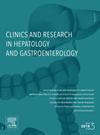肝静脉压力梯度对肝硬化门静脉血栓形成的预测价值
IF 2.6
4区 医学
Q2 GASTROENTEROLOGY & HEPATOLOGY
Clinics and research in hepatology and gastroenterology
Pub Date : 2024-10-30
DOI:10.1016/j.clinre.2024.102484
引用次数: 0
摘要
背景与目的:肝硬化门静脉血栓形成(PVT)的风险因素很多,但肝静脉压力梯度(HVPG)与PVT形成之间的关系仍不清楚:回顾性分析了2018年3月至2022年3月期间无PVT且基线时接受HVPG测量的肝硬化患者的临床结果。每 6-12 个月通过对比增强计算机断层扫描和/或磁共振成像筛查非肿瘤性 PVT 的发展:82名肝硬化患者接受了随访评估。结果:在随访期间,对 82 名肝硬化患者进行了评估,其中 12 名患者(14.6%)出现了 PVT。一年、两年和三年后,非肿瘤性 PVT 的发生率分别为 6.6%、11.7% 和 22.2%。HVPG(p=0.038;HR 1.07;95%CI 1.00-1.14)和酒精性肝病(ALD)(p=0.019;HR 4.20;95%CI 1.27-13.89)与高 PVT 风险独立相关。HVPG 的临界值为 17.52 mmHg。按 HVPG 临界值 16mmHg 分层的各组间 PVT 累计发生率差异显著(P=0.011)。HVPG≥16mmHg预测PVT发生的敏感性和特异性分别为100.0%和35.7%:结论:在肝硬化患者中,HVPG 值是预测 PVT 发生的独立因素。结论:在肝硬化患者中,HVPG 值是预测 PVT 发生的独立因素,建议在随访期间对 HVPG≥16 mmHg 的患者进行 PVT 筛查。本文章由计算机程序翻译,如有差异,请以英文原文为准。
Predictive value of hepatic venous pressure gradient in cirrhotic portal vein thrombosis development
Background & Aims
There are lots of risk factors reported for cirrhotic portal vein thrombosis (PVT) development, however, the relationship between hepatic venous pressure gradient (HVPG) and PVT development remains unclear.
Methods
The clinical outcomes of cirrhotic patients who had no PVT and underwent HVPG measurement at baseline between March 2018 and March 2022 were analyzed retrospectively. Screening for non-tumoral PVT development was implemented by contrast-enhanced computed tomography and/or magnetic resonance imaging every 6-12 months.
Results
Eighty-two cirrhotic patients were evaluated over a follow-up period. Of these, 12 patients (14.6%) experienced the development of PVT. The occurrence of non-tumoral PVT at one, two, and three years were 6.6%, 11.7%, and 22.2% respectively. HVPG (p=0.038;HR 1.07;95%CI 1.00-1.14) and alcohol liver disease (ALD) (p=0.019;HR 4.20;95%CI 1.27-13.89) were independently associated with a high PVT risk. The cutoff value of HVPG was 17.52 mmHg. The cumulative incidence of PVT differed significantly among groups stratified by HVPG thresholds of 16mmHg (P=0.011). The sensitivity and specificity of HVPG≥16mmHg in predicting PVT development were 100.0% and 35.7%.
Conclusions
In patients with liver cirrhosis, the value of HVPG was the independent predictive factor of PVT development. Screening for PVT was recommended during follow-up in patients with HVPG≥16 mmHg.
求助全文
通过发布文献求助,成功后即可免费获取论文全文。
去求助
来源期刊

Clinics and research in hepatology and gastroenterology
GASTROENTEROLOGY & HEPATOLOGY-
CiteScore
4.30
自引率
3.70%
发文量
198
审稿时长
42 days
期刊介绍:
Clinics and Research in Hepatology and Gastroenterology publishes high-quality original research papers in the field of hepatology and gastroenterology. The editors put the accent on rapid communication of new research and clinical developments and so called "hot topic" issues. Following a clear Editorial line, besides original articles and case reports, each issue features editorials, commentaries and reviews. The journal encourages research and discussion between all those involved in the specialty on an international level. All articles are peer reviewed by international experts, the articles in press are online and indexed in the international databases (Current Contents, Pubmed, Scopus, Science Direct).
Clinics and Research in Hepatology and Gastroenterology is a subscription journal (with optional open access), which allows you to publish your research without any cost to you (unless you proactively chose the open access option). Your article will be available to all researchers around the globe whose institution has a subscription to the journal.
 求助内容:
求助内容: 应助结果提醒方式:
应助结果提醒方式:


